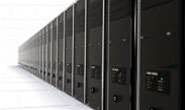The company, which is best known for office supplies, said it had built the facility with a view to a 15-year lifecycle but had adopted a virtualised and modular approach to engineering and design.

Infrastructure manager Mark Jones told iTnews that the company is currently using approximately 20 per cent of the available rack capacity.
He said that while Corporate Express had purchased some blades to enable it to run at higher computing densities, its primary server environment consisted of 16 IBM 3650 servers running some 370 virtual instances.
It is using VMware to run virtualisation on these servers and has virtualised workloads including Exchange and its SQL databases, according to Jones.
"Initially when we went into the virtualisation implementation cycle we had a view that workloads that had low latency such as databases wouldn't be good virtualisation candidates, but we've changed our minds over time," Jones said.
"We're about to upgrade to Exchange 2007 and that will be virtualised. We've also virtualised our SQL database servers as well because we're pretty confident the VMware platform can sustain the demands of those types of workloads."
Although Corporate Express runs some Microsoft applications - more than they first thought before conducting the virtualisation audit - Jones said the company saw itself as a Unix shop.
"Our core business applications run on Unix and Red Hat Linux and then we use the Microsoft platform for some supporting technologies," Jones said.
From a physical data centre design perspective, Jones said the company had selected a modular UPS blade system from Eaton and direct-drive computer room air conditioning (CRAC) from Stulz.
He said the equipment would enable the centre to use only the power it needed as it grows and also to run at temperatures of 28°C and above.
Jones said Corporate Express had also been able to build the data centre for somewhere in the vicinity of $12,000 per square metre, but wouldn't reveal the exact costs of building the facility.
However, he said that from a total cost of ownership perspective, it would work out substantially cheaper than taking a suite in a wholesale data centre.
"Our initial thought was ‘why build a data centre, let's host it in someone else's," Jones said.
"But when we did the analysis, going into an external facility looked quite attractive for three or four years, but beyond that it became cheaper to build our own."










 iTnews Executive Retreat - Security Leaders Edition
iTnews Executive Retreat - Security Leaders Edition












_(1).jpg&h=140&w=231&c=1&s=0)



